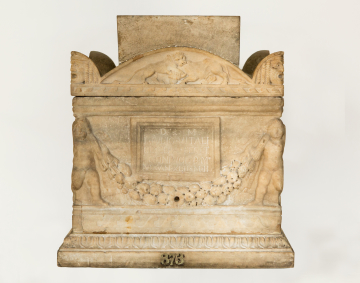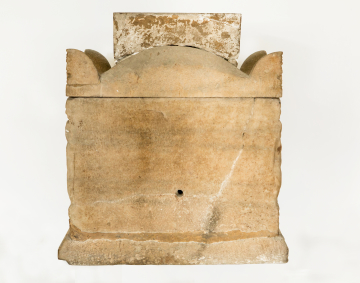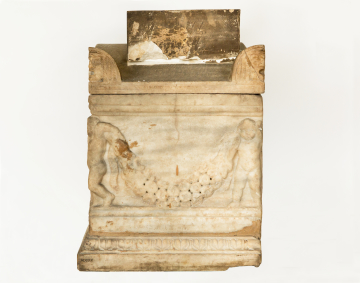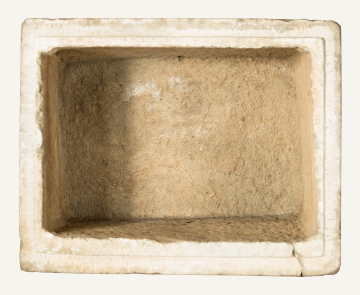Explore Collections


You are here:
CollectionsOnline
/
Roman garlanded funerary urn (cinerarium) with genii figures at the front corners and a separate lid
Browse
Roman garlanded funerary urn (cinerarium) with genii figures at the front corners and a separate lid
Proconnesian marble
Height: 45cm
Height (body): 27cm
Height (lid): 9cm
Height (body): 27cm
Height (lid): 9cm
Inscription: D M / L. IVLIO. VITALI / GLYCERA. FECIT / CONIVGI. B. M / VIX. AN. XLII. M. II
D[is] M[anibus] L[ucio] Iulio Vitali Glycera fecit coniugi b[ene] m[erenti] vix[it] an[nis] XLII m[ensibus] II
Inscription marks: Line 1: 13mm; Lines 2-5: 14mm; Line 6: 11mm.
Inscription note: Line 2: The stone appears to read EECIT; this is suggested also by the squeeze. If this is the case, it would not be an unusual mistake for a lettercutter to make.
Line 5: CIL reads only one I following XL; however, both Vermeule and Tupman read XLII.
We are grateful to Dr. Charlotte Tupman, a scholar of epigraphy (the study of inscriptions) undertaking postdoctoral research at King’s College London, who took squeezes of the inscriptions on antiquities in the Museum in 2007, for her transliteration, translation and notes/bibliography of the inscription on this piece.
Inscription translation: To the spirits of the departed. To Lucius Iulius Vitalis, Glycera set it up for her well-deserving husband, who lived forty-two years and two months.
D[is] M[anibus] L[ucio] Iulio Vitali Glycera fecit coniugi b[ene] m[erenti] vix[it] an[nis] XLII m[ensibus] II
Inscription marks: Line 1: 13mm; Lines 2-5: 14mm; Line 6: 11mm.
Inscription note: Line 2: The stone appears to read EECIT; this is suggested also by the squeeze. If this is the case, it would not be an unusual mistake for a lettercutter to make.
Line 5: CIL reads only one I following XL; however, both Vermeule and Tupman read XLII.
We are grateful to Dr. Charlotte Tupman, a scholar of epigraphy (the study of inscriptions) undertaking postdoctoral research at King’s College London, who took squeezes of the inscriptions on antiquities in the Museum in 2007, for her transliteration, translation and notes/bibliography of the inscription on this piece.
Inscription translation: To the spirits of the departed. To Lucius Iulius Vitalis, Glycera set it up for her well-deserving husband, who lived forty-two years and two months.
Museum number: M373
On display: Catacombs
All spaces are in No. 13 Lincoln's Inn Fields unless identified as in No. 12, Soane's first house.
For tours https://www.soane.org/your-visit
Curatorial note
The name plate of this urn is framed in a straight, three element moulding above and a wave pattern moulding below. The garland across the front is supported by two winged genii at the corners. Within a curved pediment lid flanked by conventional tragic-mask antefixae is a lion attacking a bull.
Inscribed
D.M.
L. IVLIO. VITALI
GLYCERA. FECIT
CONIVGI. B. M
VIX. AN. XLII. M. II
The deceased was a freedman of a family prominent under Domitian and Trajan.
For the general grouping of the decorative motives found on the front of this urn see Altmann's classification: 'Victorien und Eroten' (W. Altmann, Dir römischen Grabaltäre der Kaiserzeit, Berlin, 1905, Ch. IX, figs. 86 and 89). The Soane urn (Vermeule 339) also falls into this class.
Proconnesian marble is less frequently used for cinerary urns than for Roman second and third century AD sarcophagi (see nos. Vermeule 305 and 307 in this collection). The island of Proconnesus, the modern Marmora or Marmara in the Propontis or Euxine Sea, possessed celebrated quarries of whitish marble, which was used in the house of Mausolus and the temple at Ephesus (as recorded by Vitruvius, De Architectura, Book II, 8 and Book X, 7 and Strabo, Geographica, I, xiii). This marble was widely imported into Rome and North Africa in the Second Century and later, and was used in the arches of Severus and Constantine in Rome. Constantine also used Proconnesian marble in his new city on the Bosphorus (Constantinople) and it became the source of all Byzantine building marble.
Dr. Glenys Davies attributes this urn to Piranesi's workshop: the base of this object is similar to those of other suspected 'Piranesi' urns, which were added to the bodies later.
Inscribed
D.M.
L. IVLIO. VITALI
GLYCERA. FECIT
CONIVGI. B. M
VIX. AN. XLII. M. II
The deceased was a freedman of a family prominent under Domitian and Trajan.
For the general grouping of the decorative motives found on the front of this urn see Altmann's classification: 'Victorien und Eroten' (W. Altmann, Dir römischen Grabaltäre der Kaiserzeit, Berlin, 1905, Ch. IX, figs. 86 and 89). The Soane urn (Vermeule 339) also falls into this class.
Proconnesian marble is less frequently used for cinerary urns than for Roman second and third century AD sarcophagi (see nos. Vermeule 305 and 307 in this collection). The island of Proconnesus, the modern Marmora or Marmara in the Propontis or Euxine Sea, possessed celebrated quarries of whitish marble, which was used in the house of Mausolus and the temple at Ephesus (as recorded by Vitruvius, De Architectura, Book II, 8 and Book X, 7 and Strabo, Geographica, I, xiii). This marble was widely imported into Rome and North Africa in the Second Century and later, and was used in the arches of Severus and Constantine in Rome. Constantine also used Proconnesian marble in his new city on the Bosphorus (Constantinople) and it became the source of all Byzantine building marble.
Dr. Glenys Davies attributes this urn to Piranesi's workshop: the base of this object is similar to those of other suspected 'Piranesi' urns, which were added to the bodies later.
Rome - "Apud lapicidam (Car. Napolionem) post ecclesiam Graecorum in urbe".
Literature
Corpus Inscriptionum Latinarum (CIL), VI, iii, 20325.
Giorgi sched. Casanat. Vol. XVI (who saw it 28 October1736); Maffei M.V.281, 3.
Giorgi sched. Casanat. Vol. XVI (who saw it 28 October1736); Maffei M.V.281, 3.
Soane collections online is being continually updated. If you wish to find out more or if you have any further information about this object please contact us: worksofart@soane.org.uk











